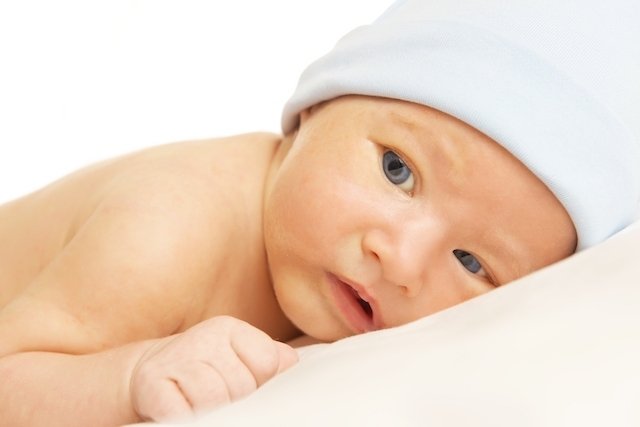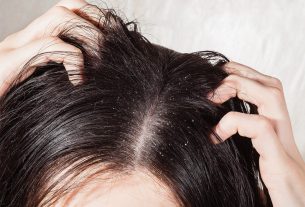Neonatal jaundice is when the baby’s skin and eyes have a yellowish color, which indicates that there may be high levels of bilirubin in the blood. It is generally caused by changes in bilirubin metabolism and is not always considered a problem.
However, when jaundice develops less than 24 hours of age, persists for more than 14 days, is intense or accompanied by other symptoms such as whitish stools or dark urine, it may be indicative of serious illnesses, such as bile duct atresia or infections.
Therefore, in the case of jaundice in a baby, it is important to consult a pediatrician for an evaluation, because identifying its cause is important to indicate the most appropriate treatment, which may involve phototherapy.

Main symptoms
The main symptoms of jaundice in babies are:
- Yellowish skin;
- Yellow eyes;
- Dark urine, in some cases;
- Whitish stools, in some cases.
Furthermore, when bilirubin levels are very high in the blood, symptoms such as difficulty eating, drowsiness and seizures can occur and indicate serious complications such as kernicterus. Understand what kernicterus is, its symptoms and causes.
If you suspect jaundice in your baby, it is important to consult a pediatrician for an evaluation, as sometimes jaundice can indicate serious problems. However, if symptoms such as drowsiness and difficulty eating occur, it is recommended to seek emergency care.
How the diagnosis is made
The diagnosis of jaundice in babies is usually made by a pediatrician taking into account the presence of yellowish skin and eyes, which generally occurs when the total bilirubin level in the blood is greater than 2.5 mg/dL. However, identifying the cause of jaundice is essential and tests are usually necessary.
Thus, blood tests, such as blood count, blood typing, bilirubin measurement and testing for antibodies against some bacteria and viruses, and imaging tests such as ultrasound may be indicated. Better understand the results of the bilirubin measurement and why it may be elevated.
This way, it is possible to confirm the jaundice and identify the cause, which is important so that the most appropriate treatment can be initiated.
Make an appointment with your pediatrician to check whether it is jaundice and thus begin the most appropriate treatment:
Taking care of your health has never been easier!
Possible causes
The main causes of jaundice in babies are:
1. Physiological jaundice
Physiological jaundice generally occurs after 24 hours of life, with a slow development of yellowish skin and eyes, due to changes in bilirubin metabolism that normally occur in newborns, and is not accompanied by other symptoms.
Normally, in this case the jaundice improves in about 2 weeks without any specific treatment being necessary, and is not considered a problem.
2. Breast milk jaundice
Breast milk jaundice usually occurs in babies fed only breast milk due to insufficient milk intake, which can lead to decreased bowel movements, which impairs the elimination of bilirubin.
Generally, the development of yellow skin and eyes occurs slowly by the end of the first week after birth and is not accompanied by other symptoms. Furthermore, in this case the jaundice tends to improve by the end of the second week of life without specific treatment.
3. Neonatal hemolytic disease
Neonatal hemolytic disease is generally caused by a blood incompatibility between mother and baby, due to the presence of antibodies that can cross the placenta and destroy the red blood cells in the newborn’s blood, leading to an increase in bilirubin levels in the blood. .
Therefore, in more serious cases, in addition to yellowing of the skin and eyes, other symptoms such as anemia, drowsiness and enlargement of the liver or spleen may also occur.
4. Bruises and hemorrhages
Sometimes, jaundice in the baby can occur due to the reabsorption of blood during the improvement of bruises and minor bleeding, which can happen after difficult births and due to the use of forceps and other types of extractors, for example.
5. Infections
Infections during the prenatal period or in the first days of life, such as herpes, syphilis, toxoplasmosis or HIV, can affect liver function and bilirubin metabolism, causing jaundice. However, other symptoms such as enlarged liver and spleen, red spots on the skin or fever often also occur.
6. Congenital hypothyroidism
Congenital hypothyroidism is when thyroid hormone deficiency is present from birth. Although it may cause few symptoms at first, in more severe cases, in addition to yellowing of the skin and eyes, symptoms such as difficulty feeding and drowsiness may occur in the first week of life. See how to identify congenital hypothyroidism and its treatment.
7. Bile duct diseases
Diseases such as bile duct atresia and choledochal cyst can impair the elimination of bile, causing an increase in bilirubin levels in the blood and the development of jaundice in the baby. In this case, the jaundice tends to be persistent and is usually accompanied by whitish stools.
Treatment of jaundice in babies
Treatment of jaundice in babies in the first days of life generally involves phototherapy and, in more severe cases, exchange transfusion, to keep bilirubin levels in the blood controlled and thus prevent the damage that bilirubin can cause to the brain.
However, depending on the cause of jaundice, specific treatment may be indicated and may involve the use of antibiotics, corticosteroids, thyroid hormone replacement and even surgery.
Phototherapy treatment
Phototherapy is the main treatment for jaundice in babies and is done by placing the baby in a small crib where they are usually just wearing a diaper and exposed to a special light that stimulates a decrease in bilirubin in the blood. Additionally, during phototherapy, a mask is placed on the baby to protect the eyes.
Depending on the severity of the jaundice, age and weight of the baby, exposure may be more or less prolonged and the device used may vary. Find out more about phototherapy.

Sign up for our newsletter and stay up to date with exclusive news
that can transform your routine!
Warning: Undefined array key "title" in /home/storelat/public_html/wp-content/plugins/link-whisper-premium/templates/frontend/related-posts.php on line 12
Warning: Undefined array key "title_tag" in /home/storelat/public_html/wp-content/plugins/link-whisper-premium/templates/frontend/related-posts.php on line 13



